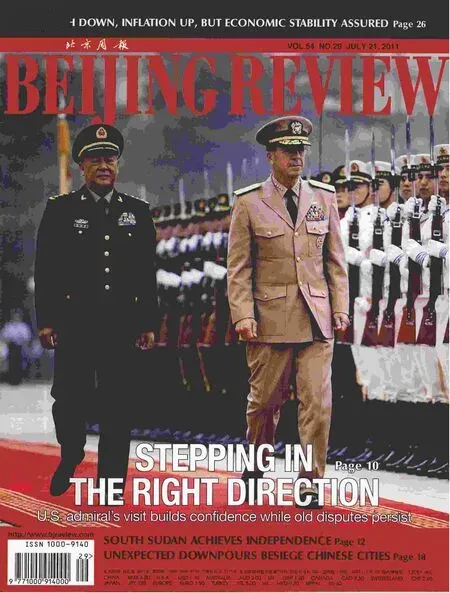Safeguarding Sustainable Growth
By LAN XINZHEN
Safeguarding Sustainable Growth
By LAN XINZHEN
The Chinese economy has continued growing steadily and rapidly,with its GDP growth reaching 9.6 percent in the fi rst half of 2011.
Since the beginning of this year, the Chinese economy has encountered several difficulties: inflation, natural disasters, closures of many small and medium-sized enterprises, and job creation pressures.Internationally, the effects of the 2008 fi nancial turmoil continue to linger and a sovereign debt crisis is plaguing Europe. Faced with mounting pressure, the Chinese Government took a number of measures to ensure the economy grows steadily.
First-half economic performance showed GDP growth continued on a downward trend. It slowed to 9.5 percent in the second quarter of this year.As a result of China’s pursuit of a healthier and more balanced growth pattern, the slowdown is what the Chinese Government expected.
In sharp contrast, consumer prices soared to new highs. Growth of the consumer price index (CPI) reached a 35-month high of 6.4 percent in June. Even so, the CPI’s growth is within the government’s control.Recent signs show price increases of CPI components, except those related to agricultural and energy products, have slowed, as macro-control measures have begun taking effect.
The slowdown of the Chinese economy won’t carry over into a larger economic downturn, and is instead an encouraging sign that China’s growth engine is back on the track of self-sustained growth from a strong rebound spurred by the counter-crisis stimulus package.
Meanwhile, the difficulties the Chinese economy faces can’t be ignored: in fl ationary pressure, emission reductions, an overheated housing market, mounting local government debts and an export slowdown as a result of anemic demand from developed economies. Although the government has been diligent in coping with these, further efforts are still needed.
The problems baf fl ing the Chinese economy have also caught worldwide attention. Concerns about the prospects for the world’s second largest economy are rising. But the international community shouldn’t just stand idly by. All countries should abandon any form of trade and investment protectionism, safeguard an environment for mutual bene fi t and get the world’s growth engine roaring again. We appreciate that the United States hasn’t begun printing more money in a third round of quantitative easing,and that EU members are working on solutions to the sovereign debt crisis in Greece and Spain.
In the future, China needs to strike a balance between maintaining steady and fast growth, restructuring the economy and managing in fl ationary expectations.
In the short term, managing in fl ationary expectations is crucial, which explains why China’s central bank increased reserve requirement ratios six times and interest rates three times in the fi rst half of 2011. In the long run,the government should avoid over-tightening its monetary policies. Overtightening could lead to de fi cient cash fl ows for enterprises and projects already in progress and result in massive loan defaults for banks.
The Chinese Government should take preventive measures to ensure healthy and sustainable growth, which will be a main driving force in the global economic recovery.

